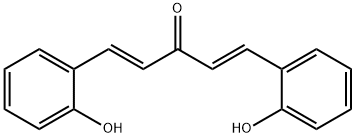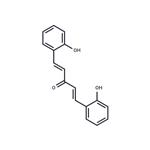Description
Nrf2 activation of the antioxidant response element (ARE) is central to cytoprotective gene expression against oxidative and/or electrophilic stress. Unless activated by inflammatory, environmental, or oxidative stressors, Nrf2 is sequestered in the cytoplasm by its repressor, Keap1. Because of its protective capabilities, small molecules that activate Nrf2 signaling are being examined as potential anti-
cancer or anti-
inflammatory agents. 2-
HBA, a synthetic analog of curcumin, is an indirect inducer of enzymes that catalyze detoxification reactions through the Keap1-
Nrf2-
ARE pathway. As a double Michael reaction acceptor, 2-
HBA can directly modify cysteine sulfhydryl groups in Keap1 and consequently suppress Nrf2 ubiquitination, which leads to enhanced expression of antioxidative and cytoprotective enzymes. 2-
HBA doubles the specific activity of NAD(P)H:quinone acceptor oxidoreductase 1 (NQO1) in Hepa1c1c7 cells at 0.15 μM. In rapidly dividing mouse leukemia L1210 cells, 0.6 μM 2-
HBA increases the activities of NQO1, glutathione reductase, and the levels of total glutathione. At 5-
15 μM, 2-
HBA causes G
2/M cell cycle arrest and p53-
independent, caspase 3-
mediated apoptosis.
Uses
(E,E)-Bis(2-hydroxybenzylidene)acetone (2-HBA) is a synthetic analogue of curcumin that displays strong NAD(P)H:quinone reductase (NQO1) inducer potency in Hepa 1c1c7 cells. 2-HBA, a double Michael reaction acceptor, can directly modify cysteine sulfhydryl groups in Keap1 and consequently suppress Nrf2 ubiquitination which in turn enhances the expression of antioxidative and cytoprotective enzymes. 2-HBA has also been shown to cause G2/M cell cycle arrest and p53-independent, caspase 3-mediated apoptosis.
in vitro
2-hba could markedly increase the activities of nad(p)h:quinone acceptor oxidoreductase 1 (nqo1) and glutathione reductase, the levels of total glutathione, as well as the phase 2 response markers. in addition, at high concentrations 2-hba caused g2/m cell cycle arrest and apoptosis. moreover, the mutant l1210 cell line was found to be more sensitive to the apoptotic effects of 2-hba [1].
in vivo
the effect of 2-hba on the dmba-induced expression of the ha-ras gene in isolated rna tissues of cba/ca inbred mice was investigated. according to the previous findings, elevated ha-ras expression was obserrved even 24 h after dmba treatment. administration of 2-hba with dmba could lead to a decrease of the dmba-induced ha-ras gene expression in all the investigated tissues, suggesting metabolic interaction of 2-hba and dmba. in addiiton, administration of 2-hba 24 h prior to the dmba treatment was able to reduce the ha-ras gene expression in all tested tissues except the liver, which could be the result of a possible cyp1a inducer and pro-oxidant effects of 2-hba [2].
References
[1] a. t. dinkova-kostova, a. h. cory, r. e. bozak, et al. bis(2-hydroxybenzylidene)acetone, a potent inducer of the phase 2 response, causes apoptosis in mouse leukemia cells through a p53-independent, caspase-mediated pathway. cancer letters 245, 341-349 (2007).
[2] perjési p, ember i, bozak re, nádasi e, rozmer z, varjas t, hicks rj. effect of the chalcone analog e,e-bis(2-hydroxybenzylidene) acetone on the 7,12-dimethylbenz[a]anthracene-induced ha-ras gene activity in vivo. in vivo. 2006 jan-feb;20(1):141-6.


